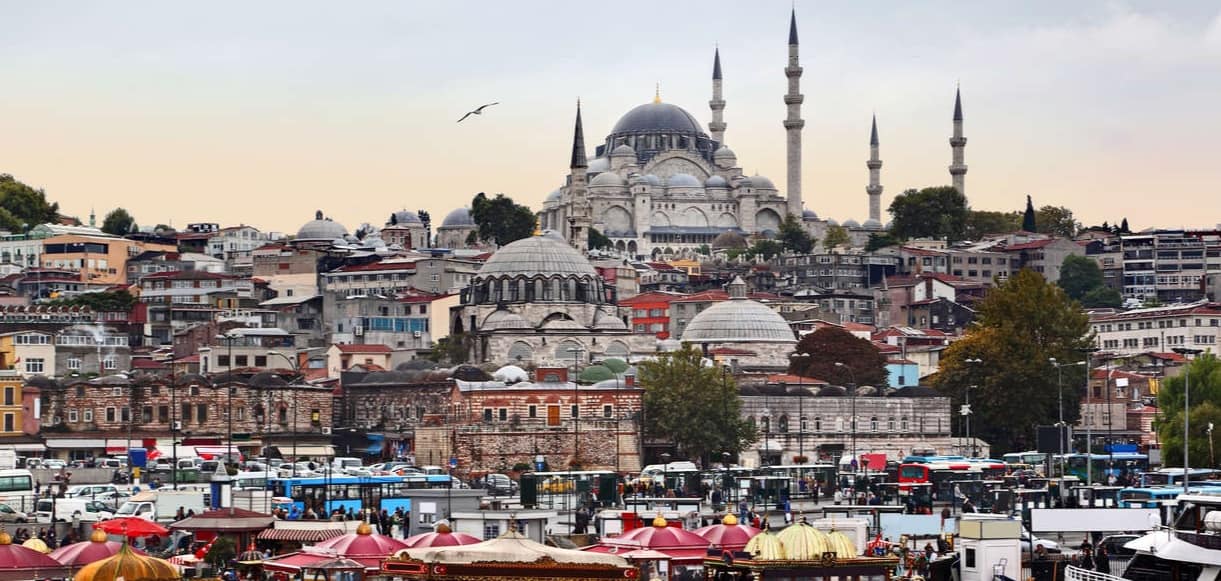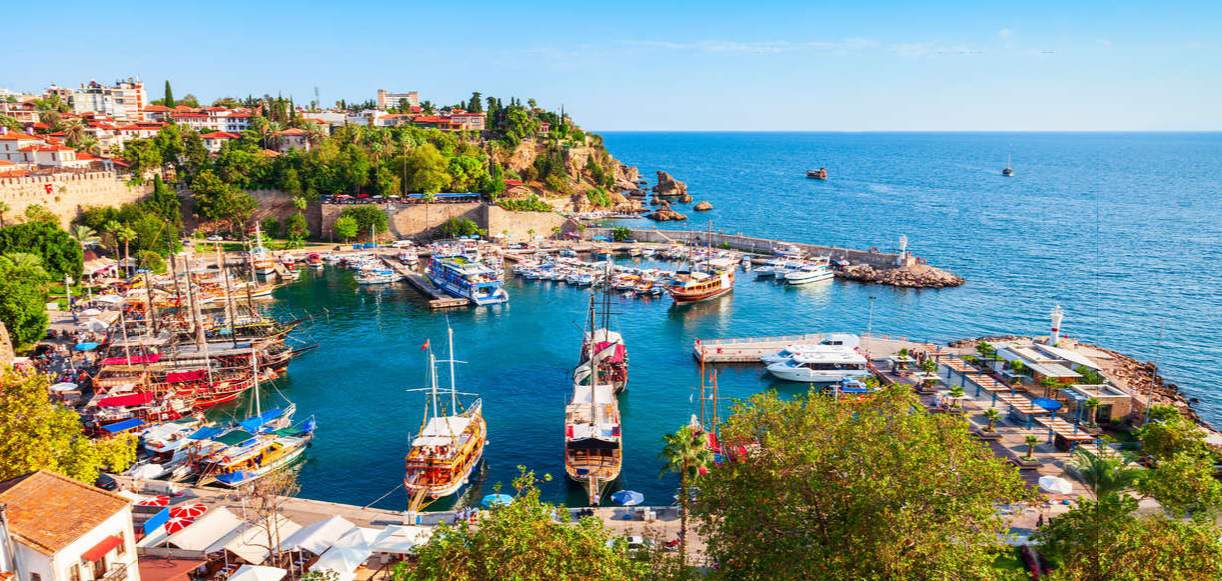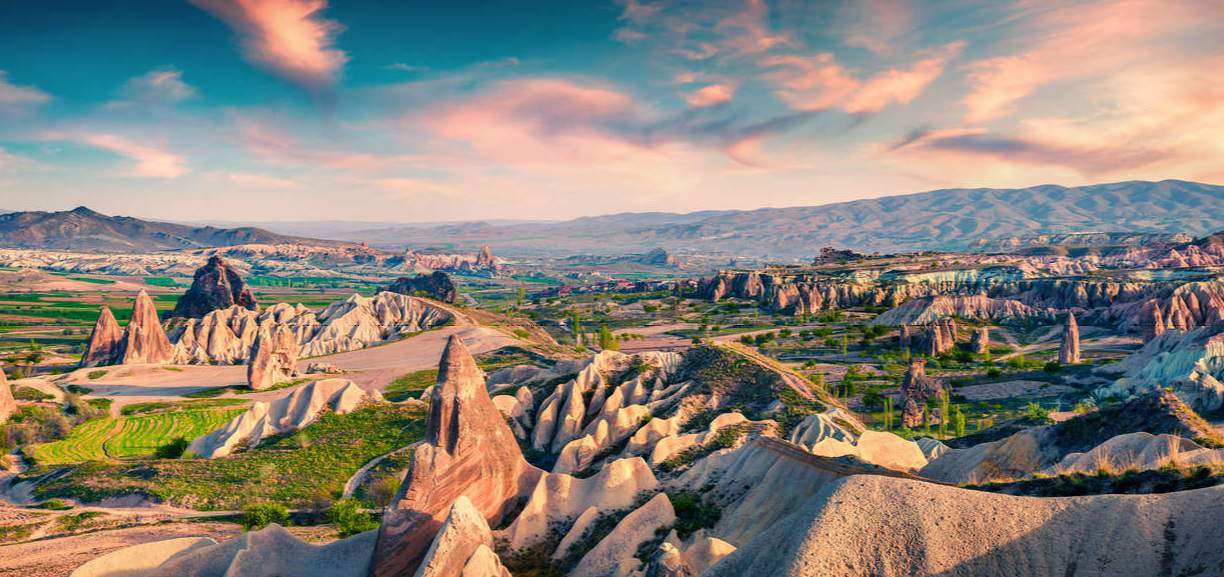Why book this trip?Turkey is a country of contrasting landscapes and immense cultural riches. This all-encompassing trip takes-in Istanbul, the impressive ancient sites of Aphrodisias and Ephesus, the unusual terraces of Pamukkale, and visits the World War I battlefields of Gallipoli.
Cappadocia– Explore the fairy-tale chimneys and rock carved cave dwellings Gallipoli– Discover the poignant World War I memorials including the Lone Pine Cemetery Turquoise Coast– Take a tranquil boat ride through the reeds to Caunos and swim at Iztuzu Beach
INCLUDED MEALS Breakfast: 14TRIP STAFF Explore Tour Leader – Driver(s)TRANSPORT Bus – Boat – FerryACCOMMODATION – 14 nights comfortable hotelTRIP PACE: Full onGROUP SIZE: 12 – 18
Itinerary- DAY 1– Join trip in Istanbul
Arrive in Istanbul. As Constantinople, the city was the capital of both the Byzantine and Ottoman Empires, so today it is steeped in history and fascinating architecture. Modern day Istanbul has much to offer – not least its mouth-watering cuisine and budding cafe culture. The city straddles between Europe and Asia and because of this, it was an important stop on the old Silk Road. It is a melting pot of different cultures and this is demonstrated in its gastronomy. Turkish food is a hearty mix of Middle Eastern, Asian and Balkan style dishes that range from barbecued meat kebabs to vine leaf wrapped vegetable and rice parcels. For those arriving on time our Leader plans to meet you in the hotel reception at 7pm for the welcome meeting and for those that wish, there is the chance to go out for dinner. There are no other activities planned today, so you are free to arrive in Istanbul at any time. If you would like to receive a complimentary airport transfer today, you’ll need to depart from Istanbul Airport (IST), which is about one hour and 30 minutes’ drive or Sabiha Gokcen International Airport (SAW), which is around two hours’ drive from the city centre, depending on traffic, which can be heavy at times. Should you miss the welcome meeting, your Leader will inform you of any essential information as soon as you catch up. Our conveniently located hotel is within walking distance or a short tram ride of many of the cultural and historical sites in the Sultanahmet district. If your flight arrives earlier in the day, perhaps you might choose to explore this area. If your flight is arriving earlier today or if you’re extending your stay by a night then we’d recommend visiting Istanbul’s Grand Bazaar, as it is closed on a Sunday, so there won’t be the opportunity to go tomorrow. Located within the walls of Istanbul, there are around 60 streets and over 3,000 shops selling everything from jewellery to carpets and textiles and furniture to local arts and crafts. It’s one of the oldest and largest covered markets in the world. The labyrinth of streets also house two mosques, two hamams (Turkish baths) and an array of restaurants and cafes, so there is plenty to experience in this historic landmark of Istanbul.
- DAY 2– Walking tour of Istanbul including the Blue Mosque
This morning we’ll get our first chance to try a traditional Turkish breakfast which usually consists of fresh cucumbers, tomatoes, olives and occasionally fruit. Along with a variety of yogurts, cheese and bread. We then explore the ‘Old City’ on foot, visiting the famous Blue Mosque, the opulent Topkapi Palace and the historic hub of Sultanahmet Square. This afternoon is free for you to explore at your own pace. You may choose to visit the impressive 6th century Sunken Palace cisterns or the great Hagia Sophia, which reined as the greatest church in Christendom for 900 years. Alternatively, there is the chance to take a boat trip on the Bosphorus, offering stunning views of the Istanbul skyline. To appreciate the wonderful skyline of domes and minarets further, you may opt to climb the Galata Tower. This evening, you might choose to enjoy Istanbul’s nightlife, with its large selection of restaurants, bars and entertainment. Your local Leader will be able to offer you advice based on your preferences.
- DAY 3– Travel to Ankara; visit Ataturk’s Mausoleum and the Museum of Anatolian Civilisations
Leaving Turkey’s largest city behind us this morning at about 7am, we head for the capital of Ankara. Our journey will take approximately six hours, but we travel through interesting countryside and have plenty of breaks. During the summer months, we are likely to pass through huge expanses of sunflowers – an important oil crop in the country. When we get to Ankara, we will visit the impressive Mausoleum of Mustafa Kemal Ataturk, which is around three and a half hours’ drive. This monumental building sits high above the city and honours the highly respected leader of Turkey’s fight for independence, widely regarded as the founder of modern Turkey. We also visit the superb Museum of Anatolian Civilisations, which gives a fantastic overview of Turkey’s complex history. This evening, our centrally located hotel provides an excellent base from which to explore the capital’s restaurants and bars.
- DAY 4– Visit Hacibektas Museum en route to Urgup; see Kaymakli underground city
This morning, we set off on our journey to Cappadocia, stopping en route in Hacibektas, which is around three and a half hours’ drive. The museum here once housed the famous Bektashi Dervish sect and is now recreated as it would have looked during the 13th century. An hour’s further drive takes us to Urgup – our base for the next two nights from which we will explore the lunar landscape of Cappadocia. This area is famed for its unique geological formations and a history that stretches back to before the Hittites (2000 BC). This afternoon we visit Kaymakli Underground City. Built by Christians escaping Arab oppression and once home to 3,500 people, this troglodyte cave-city is one of the largest of 34 similar excavations in Cappadocia. Built under the Citadel of Kaymakli, it contains nearly 100 tunnels on eight subterranean floors. We will explore the four that are open to the public, containing stables, a church and storage places. After a busy day exploring you might like to try a popular local yoghurt drink called, ayran, it has an unusual salty and soured milk flavour.
- DAY 5– Full day in Cappadocia
Later this morning we have the option of taking a three-hour walk through the remarkable Red and Rose Valleys, helping us to gain a better appreciation of this landscape. Formed by volcanic eruptions which covered the valleys with mud, ash and blocks of hard rock, over the ages this volcanic ‘tufa’ was sculpted by erosion into strange and improbable shapes. Byzantine hermits settled in this area and carved churches, houses, fortresses and even complete underground cities into these cone formations known as fairy-tale chimneys. This afternoon we visit Uchisar Castle, where rooms are carved into this massive rock on the top of the Uchisar citadel. From its peak, magnificent views can be gained of the whole region including the valleys that we walked through yesterday. We also spend time in the UNESCO World Heritage Site of the Goreme Open Air Museum, where we will explore its many rock-carved churches and monastic buildings; some of which feature a stunning collection of wall paintings.
- DAY 6– Konya, home to the Whirling Dervishes en route to Antalya
Leaving Cappadocia at around 7am this morning today is one of our longest days. Our first stop is the 13th century Sultanhani Caravansarai – once the largest roadside inn in Turkey, supporting the flow of commerce between the East and the West. We then drive for a further two hours to Konya – Turkey’s holiest city and the home of the Mevlana sect, better known as the Whirling Dervishes. Here, we will visit the Mevlana Museum to learn more about Sufism and the Whirling Dervish tradition. After lunch we head back onto the open road driving to Antalya, the gateway to Turkey’s southern Mediterranean. On arrival we will head into the delightful old town of Antalya much of which dates back to Roman and Byzantine times. Wander around the narrow cobblestones streets and head to the historic harbour which hosts a good selection of restaurants, cafes and bars. In total today we drive for approximately seven hours, but our journey is broken up by the stops we make along the way.
- DAY 7– Journey to Kas via the ancient town of Olympos
This morning at around 9am we drive towards the illustrious ancient town of Olympos, which takes us around ninety minutes. Although its early history is shrouded in mystery, we do know that it was an important Lycian city by the 2nd century BC and that the Olympians worshipped Hephaestus (Vulcan), the god of fire. Today, only fragmentary ruins remain in a lush, overgrown site overlooking the tropical coastline. We will enjoy a short, but steep uphill walk through forest to the ‘Chimaera’ eternal flame, before having the opportunity to enjoy a refreshing dip in the sea – don’t forget to bring your swim wear and a towel. Those who would prefer not to join this walk can choose to relax in the cafe at the bottom of the hill. Our journey continues along the Turquoise coast (so named because of the clear waters of the Aegean Sea) to the unspoilt coastal town of Kas – our base for the next two nights.
- DAY 8– In Kas with the chance to sea kayak or visit Xanthos
With its old Greek houses and their picturesque balconies, the tiny seaport of Kas is one of the most beautiful on the Turkish Riviera. Today has been left free for you to relax and soak up the town’s charming atmosphere or take part in an optional activity. You could take a boat trip to see the sunken ruins at Kekova or try your hand at sea kayaking. Kas is also a great place to pick up souvenirs, but don’t forget to haggle! For a little more culture, it is possible to arrange a trip to the UNESCO World Heritage Site of the ancient city of Xanthos.
- DAY 9– Boat ride to Caunos and Iztuzu Beach; arrive in Dalyan
Today’s early morning drive to Dalyan allows us to enjoy a gentle riverboat trip through the reeds of the Koycegiz River, looking out for loggerhead turtles in this serene setting. After viewing the rock-cut tombs of ancient Caunos from the water, we step onto dry land to explore the ruins further, which date back to 400 BC. Once again, we recommend packing your swimming costume today, as we have the opportunity for a dip in the inviting turquoise sea at Iztuzu Beach. Whilst here there is also the chance to visit the Turtle Conservation Centre (DEKAMER) before returning to Dalyan. The conservation centre works to protect the turtle nesting areas on Iztuzu Beach, cares for and rehabilitates injured turtles and also attempts to educate the local fisherman on the importance of using propeller guards. Later this afternoon we head to Dalyan and check-in to our hotel for the night. Today we spend around three hours driving and about the same duration travelling by boat.
- DAY 10– Visit the ancient sites of Pamukkale and Hierapolis
Today we drive for about four hours to our hotel in Pamukkale. After spending the early afternoon relaxing by the pool, we will head out to explore one of Turkey’s most amazing natural wonders known as the ‘cotton castle,’ taking its name from the white calcareous concretions deposited by mineral springs. Above the terraced pools you’ll find the ancient spa town of Hierapolis where the ruins date back to 2nd century BC and the time of Eumenes II. Earthquakes have rocked the area throughout history and the site was finally abandoned in 1334 following a particularly strong quake, but as recently as the mid-20th century, hotels were being constructed on top of its priceless ruins. Luckily, UNESCO World Heritage status has saved it from further damage. You can visit the theatre, Temple of Apollo, Frontinus Gate and see a number of sarcophagi as well as having the chance to go into the Archaeology Museum housed in the former Roman baths. We move on to the ‘frozen waterfall’. Situated on a high escarpment, Pamukkale has been an attraction since Roman times. Stalactites of a bright white petrified waterfalls cascade from basin to basin. We visit the incredible travertine pools, where you can opt to swim and enjoy the views overlooking the Menderes Valley. Don’t miss Cleopatra’s Pool – an oasis of beauty with a mirror-like clarity that allows us to see deep down to the ruins below.
- DAY 11– Visit Aphrodisias Greco-Roman site; arrive in Selcuk
Today we visit the very impressive Greco-Roman site of Aphrodisias, where the goddess of love once bestowed her sensual favours on her willing devotees. The drive here takes around an hour and a half. This site is in many ways as spectacular as Ephesus, but far quieter by comparison, and there’s also an excellent museum on site that you may like to visit. The tetrapylon is a wonderfully ornate example of a huge gateway which would have once welcomed you into the main street leading to the Temple of Aphrodite. The well-preserved odeon and theatre are also well worth seeing, as is the Sebasteion, which is carved with reliefs depicted Aphrodite and her worshippers. The piece de resistance has to be the stadium which measures 270 metre long by 60 metres wide and would have held 30,000 spectators. On the seats you’ll find carvings into the rock, which have been graffitied during the athletic events that took place here. Later, a three hour drive takes us to Selcuk, our base for two nights.
- DAY 12– Explore Ephesus; chance to visit Selcuk Museum
Today we visit Selcuk’s historic neighbour, the great Greco-Roman city of Ephesus. We aim to get there in time for the site opening and before it becomes overly crowded with visitors. Once visited by Mark Anthony and Cleopatra, and also by St. Paul, inspiring the Epistle to the Ephesians, this famous Asia Minor seaport reached its zenith in the 2nd century AD, becoming one of the main cultural and economic centres of the ancient world until it went into decline after the 7th century. It boasted an excellent gymnasia and a stadium with seating for 70,000 spectators. Other highlights include the Baths of Constantine, the brothel, the Temple of Hadrian with its beautiful facade, the theatre (a giant with 24,000 seats) and the odeon (a 2000 seat music and poetry centre), the Arcadian Way (where Cleopatra entered from the harbour) and the Marble Avenue featuring the 2-storey Library of Celsus, which is one of the most photographed Greco-Roman buildings in the world. Driving on a short distance, we will visit the famous Temple of Artemis, one of the Seven Wonders of the Ancient World, before returning to Selcuk for a free afternoon. In your own time, you may choose to explore St John’s Basilica, the Isa Bey Mosque or Selcuk Museum. Alternatively, you may prefer to enjoy a bit of shopping or relaxation, soaking up the town’s laid-back vibe. Selcuk is the ideal place to people-watch as you sip Turkish tea with the backgammon-playing locals in the many open air caf’s and parks.
- DAY 13– See Pergamum Acropolis and Troy en route to Canakkale
This morning we leave our hotel at about 7am to continue our journey north, past the endless olive groves and pomegranate trees, to the Greco-Roman remains of Pergamum, now the typical Turkish town of Bergama. Pergamum gave its name to the word ‘parchment’, for which it was famous for throughout the Middle East. We visit the ancient Acropolis and later continue to the ancient site of Troy where, according to legend, the artful Ulysses devised the Wooden Horse Strategy, thereby ending the 10 year Trojan War. Here, nine ruined cities, one on top of the other, have been uncovered, going back some 5,000 years. Troy VI is the assumed walled city of King Priam (1800-1275 BC), celebrated by the blind Greek poet Homer in the Iliad and all but lost in legend until unearthed by amateur archaeologist Schliemann in 1871. Later this afternoon, we drive a short distance to our hotel for the night, in Guzelyal. Arrive at about 5.30pm. Today is one of our longest drives and we travel for approximately seven hours.
- DAY 14– Travel to the Gallipoli Battlefields; return to Istanbul
We leave early this morning at around 6.30am to board the ferry for the short crossing (around 30 minutes’) across the Dardanelles Straits to the Gallipoli Peninsula. It was here in 1916 that, after much bloody hand-to-hand fighting and loss of life, the ill-fated Allied campaign was forced to concede victory to the Turks and withdraw. We will visit Anzac Cove – the infamous site of the Anzac landing, as well as the Lone Pine Australian Memorial and Cemetery before following the shoreline of the Sea of Marmara back to Istanbul for our final evening. The drive back to the city takes around four and a half hours.
- DAY 15– Trip ends in Istanbul
The trip ends after breakfast at our hotel in Istanbul. There are no activities planned today, so you are free to depart from Istanbul at any time. If your flight is departing later in the day luggage storage facilities are available at our hotel. If you would like to receive a complimentary airport transfer today, you’ll need to depart from Istanbul Airport (IST), which is about one hour and 30 minutes’ drive or Sabiha Gokcen International Airport (SAW), which is around two hours’ drive from the city centre, depending on traffic, which can be heavy at times.
|












